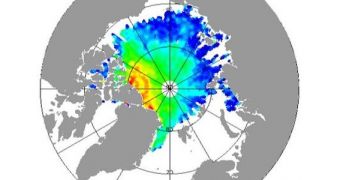At the American Geophysical Union's (AGU) fall meeting in San Francisco last week, researchers from the Center for Polar Observation and Modeling, in the UK, presented a new series of satellite data that revealed how the volume of sea ice at the North Pole has increased during this autumn.
According to the new measurements, which were conducted using the European Space Agency's (ESA) CryoSat polar observations satellite, the amount of ice in the Arctic this autumn was 50 percent higher compared to a similar interval last year. CryoSat saw a total of 9,000 cubic kilometers (2,160 cubic miles) of sea ice at the North Pole this October.
During the same month in 2012, average levels were just 6,000 cubic kilometers (1,440 cubic miles). Tracking sea ice thickness and spread is extremely difficult because the material moves around, and tends to change its thickness at the same location many times over the course of a year.
“We didn’t expect the greater ice extent left at the end of this summer’s melt to be reflected in the volume. But it has been, and the reason is related to the amount of multiyear ice in the Arctic,” study leader and CPOM investigator Rachel Tilling told the conference. She added that CryoSat would continue long-term measurements of the Arctic.

 14 DAY TRIAL //
14 DAY TRIAL //